Relevance of Budgeting and Costing in Modern Business Environment
VerifiedAdded on 2023/03/20
|13
|3547
|25
Essay
AI Summary
This essay examines the relevance of traditional budgeting and standard costing within the contemporary business environment, as prompted by Jensen's critique of corporate budgeting and the arguments of Johnson and Kaplan regarding the limitations of standard costing and variance analysis. The essay begins by defining and analyzing traditional budgeting, including its role in strategic planning, its significance in providing direction and control, and its limitations such as high costs and inflexibility. It then proceeds to define standard costing, its importance in enhancing efficiency, resource utilization, and budgeting, as well as its limitations like potential for manipulation and rigidity. The essay draws from the provided readings, including Jensen (2001) and Hope and Fraser (2003), to explore the advantages and disadvantages of each method, providing a comprehensive overview of their application and implications in today's competitive business landscape. The essay concludes with a balanced assessment of the role of each method in modern business accounting practices.
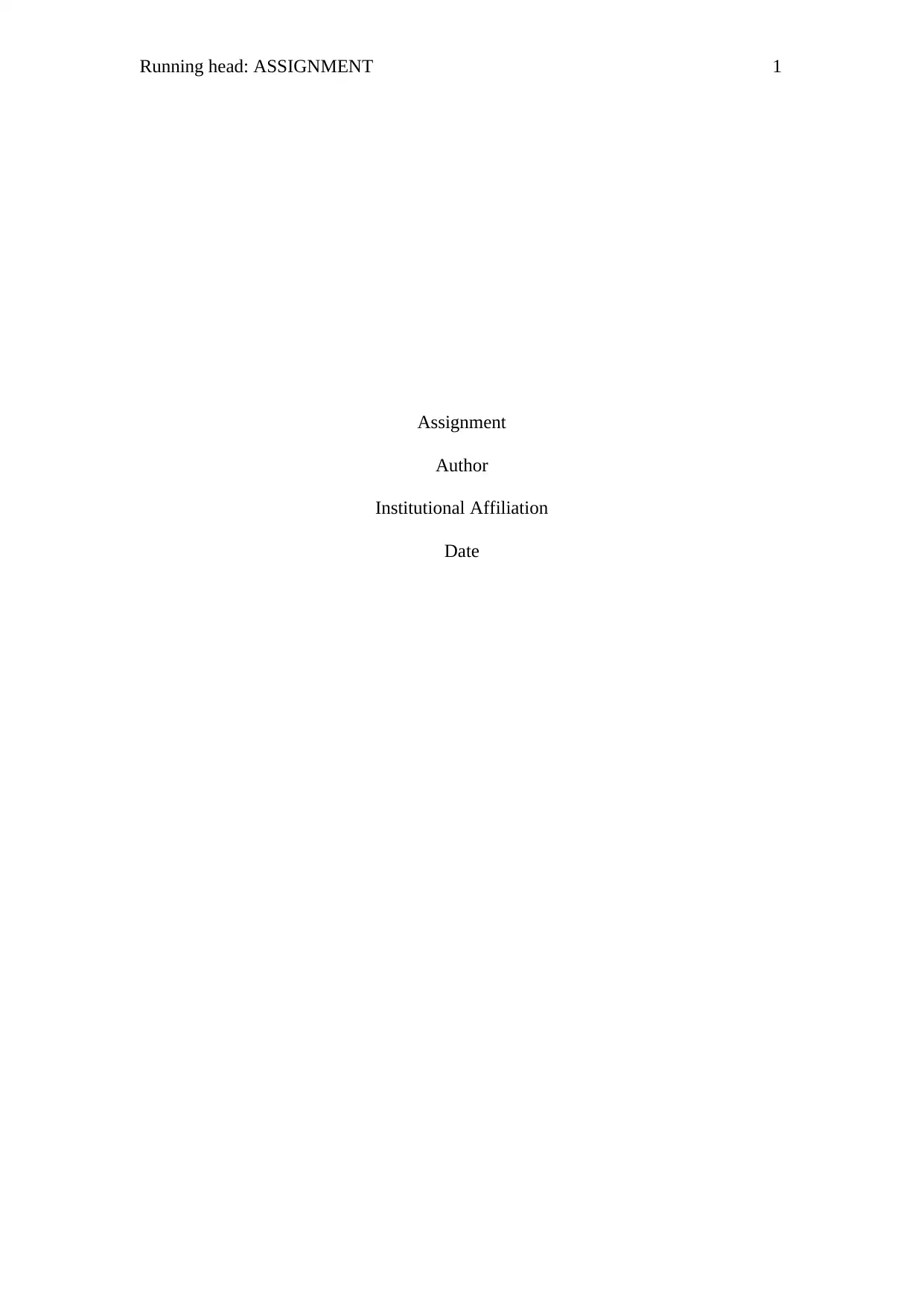
Running head: ASSIGNMENT 1
Assignment
Author
Institutional Affiliation
Date
Assignment
Author
Institutional Affiliation
Date
Paraphrase This Document
Need a fresh take? Get an instant paraphrase of this document with our AI Paraphraser
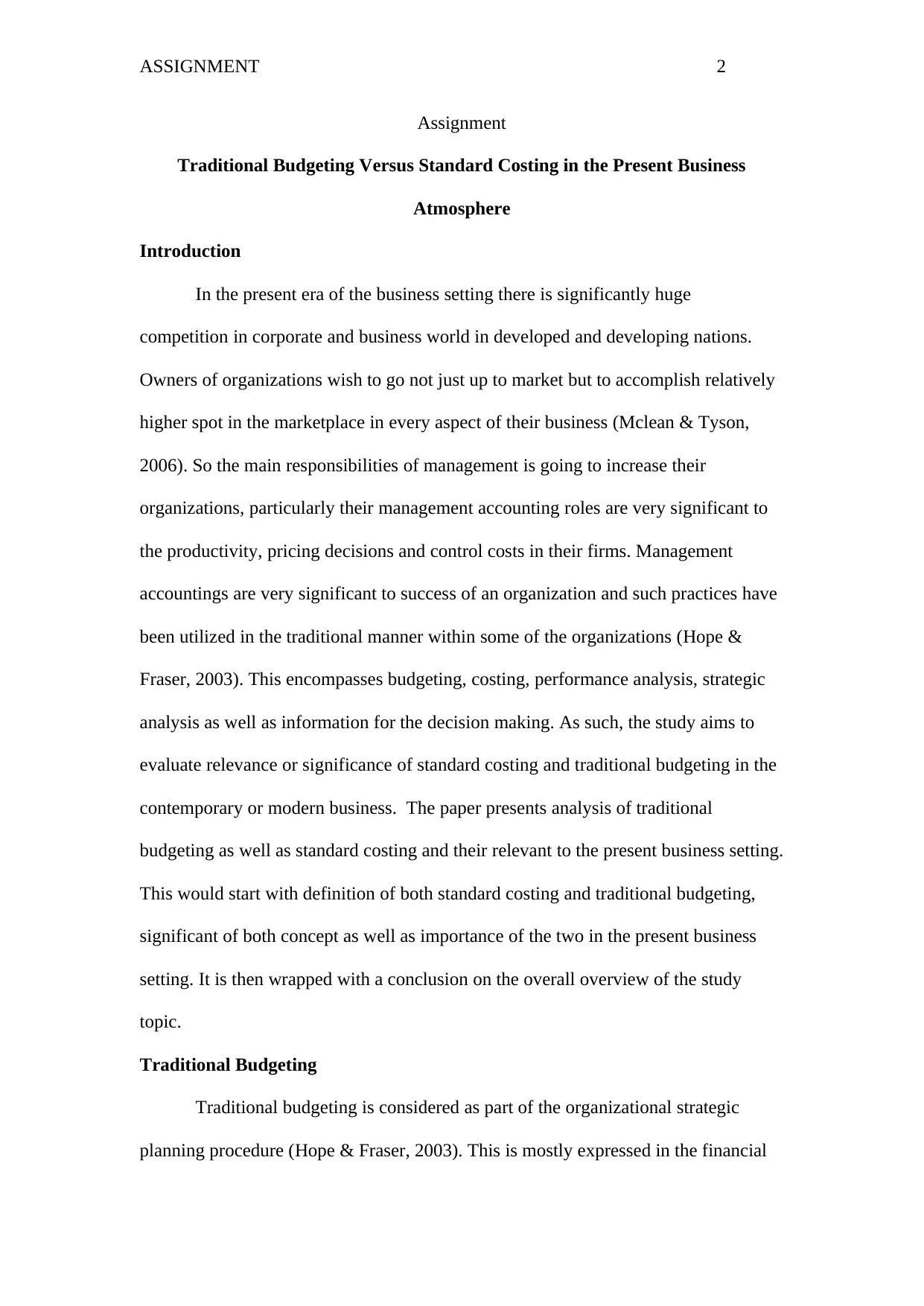
ASSIGNMENT 2
Assignment
Traditional Budgeting Versus Standard Costing in the Present Business
Atmosphere
Introduction
In the present era of the business setting there is significantly huge
competition in corporate and business world in developed and developing nations.
Owners of organizations wish to go not just up to market but to accomplish relatively
higher spot in the marketplace in every aspect of their business (Mclean & Tyson,
2006). So the main responsibilities of management is going to increase their
organizations, particularly their management accounting roles are very significant to
the productivity, pricing decisions and control costs in their firms. Management
accountings are very significant to success of an organization and such practices have
been utilized in the traditional manner within some of the organizations (Hope &
Fraser, 2003). This encompasses budgeting, costing, performance analysis, strategic
analysis as well as information for the decision making. As such, the study aims to
evaluate relevance or significance of standard costing and traditional budgeting in the
contemporary or modern business. The paper presents analysis of traditional
budgeting as well as standard costing and their relevant to the present business setting.
This would start with definition of both standard costing and traditional budgeting,
significant of both concept as well as importance of the two in the present business
setting. It is then wrapped with a conclusion on the overall overview of the study
topic.
Traditional Budgeting
Traditional budgeting is considered as part of the organizational strategic
planning procedure (Hope & Fraser, 2003). This is mostly expressed in the financial
Assignment
Traditional Budgeting Versus Standard Costing in the Present Business
Atmosphere
Introduction
In the present era of the business setting there is significantly huge
competition in corporate and business world in developed and developing nations.
Owners of organizations wish to go not just up to market but to accomplish relatively
higher spot in the marketplace in every aspect of their business (Mclean & Tyson,
2006). So the main responsibilities of management is going to increase their
organizations, particularly their management accounting roles are very significant to
the productivity, pricing decisions and control costs in their firms. Management
accountings are very significant to success of an organization and such practices have
been utilized in the traditional manner within some of the organizations (Hope &
Fraser, 2003). This encompasses budgeting, costing, performance analysis, strategic
analysis as well as information for the decision making. As such, the study aims to
evaluate relevance or significance of standard costing and traditional budgeting in the
contemporary or modern business. The paper presents analysis of traditional
budgeting as well as standard costing and their relevant to the present business setting.
This would start with definition of both standard costing and traditional budgeting,
significant of both concept as well as importance of the two in the present business
setting. It is then wrapped with a conclusion on the overall overview of the study
topic.
Traditional Budgeting
Traditional budgeting is considered as part of the organizational strategic
planning procedure (Hope & Fraser, 2003). This is mostly expressed in the financial
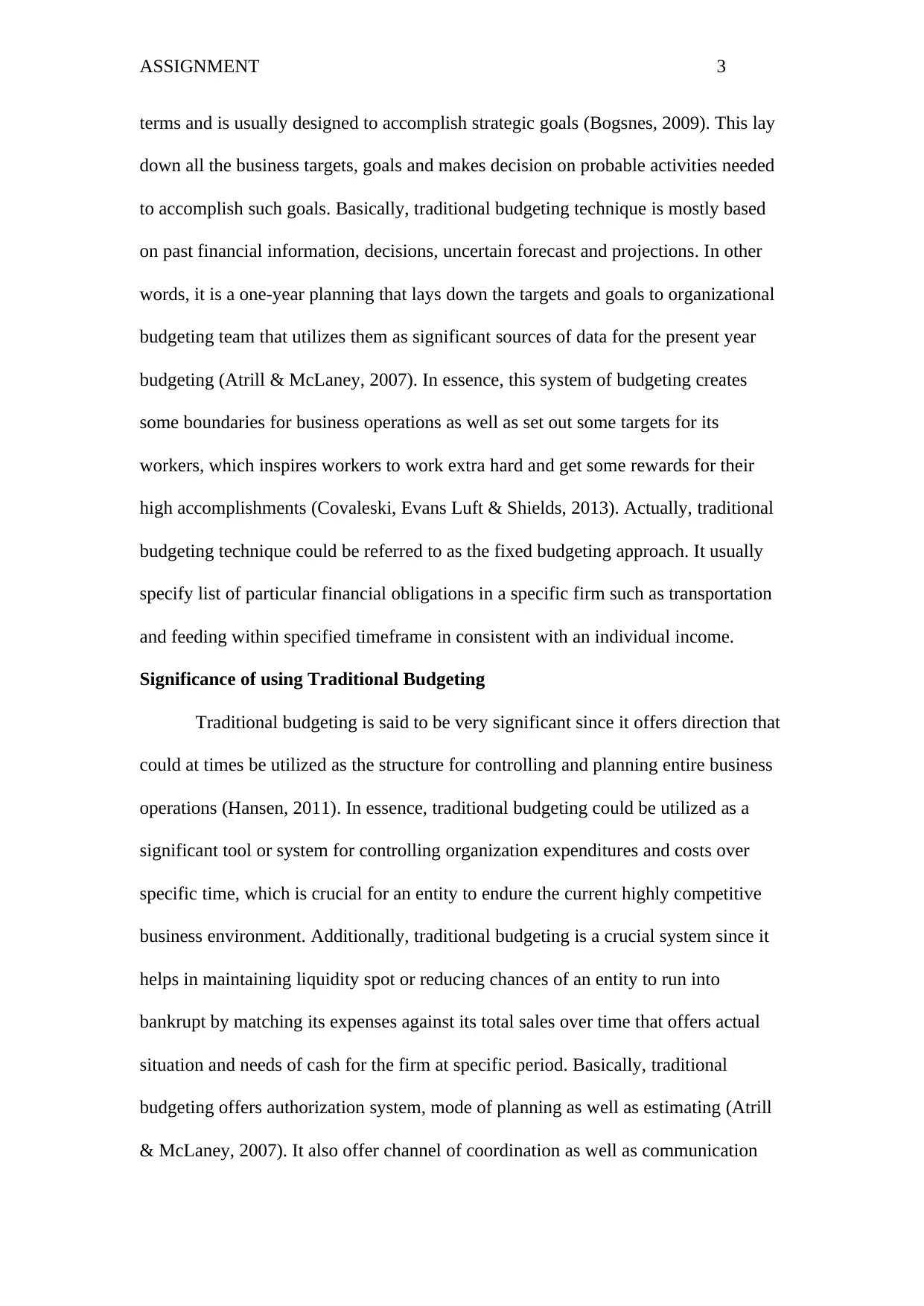
ASSIGNMENT 3
terms and is usually designed to accomplish strategic goals (Bogsnes, 2009). This lay
down all the business targets, goals and makes decision on probable activities needed
to accomplish such goals. Basically, traditional budgeting technique is mostly based
on past financial information, decisions, uncertain forecast and projections. In other
words, it is a one-year planning that lays down the targets and goals to organizational
budgeting team that utilizes them as significant sources of data for the present year
budgeting (Atrill & McLaney, 2007). In essence, this system of budgeting creates
some boundaries for business operations as well as set out some targets for its
workers, which inspires workers to work extra hard and get some rewards for their
high accomplishments (Covaleski, Evans Luft & Shields, 2013). Actually, traditional
budgeting technique could be referred to as the fixed budgeting approach. It usually
specify list of particular financial obligations in a specific firm such as transportation
and feeding within specified timeframe in consistent with an individual income.
Significance of using Traditional Budgeting
Traditional budgeting is said to be very significant since it offers direction that
could at times be utilized as the structure for controlling and planning entire business
operations (Hansen, 2011). In essence, traditional budgeting could be utilized as a
significant tool or system for controlling organization expenditures and costs over
specific time, which is crucial for an entity to endure the current highly competitive
business environment. Additionally, traditional budgeting is a crucial system since it
helps in maintaining liquidity spot or reducing chances of an entity to run into
bankrupt by matching its expenses against its total sales over time that offers actual
situation and needs of cash for the firm at specific period. Basically, traditional
budgeting offers authorization system, mode of planning as well as estimating (Atrill
& McLaney, 2007). It also offer channel of coordination as well as communication
terms and is usually designed to accomplish strategic goals (Bogsnes, 2009). This lay
down all the business targets, goals and makes decision on probable activities needed
to accomplish such goals. Basically, traditional budgeting technique is mostly based
on past financial information, decisions, uncertain forecast and projections. In other
words, it is a one-year planning that lays down the targets and goals to organizational
budgeting team that utilizes them as significant sources of data for the present year
budgeting (Atrill & McLaney, 2007). In essence, this system of budgeting creates
some boundaries for business operations as well as set out some targets for its
workers, which inspires workers to work extra hard and get some rewards for their
high accomplishments (Covaleski, Evans Luft & Shields, 2013). Actually, traditional
budgeting technique could be referred to as the fixed budgeting approach. It usually
specify list of particular financial obligations in a specific firm such as transportation
and feeding within specified timeframe in consistent with an individual income.
Significance of using Traditional Budgeting
Traditional budgeting is said to be very significant since it offers direction that
could at times be utilized as the structure for controlling and planning entire business
operations (Hansen, 2011). In essence, traditional budgeting could be utilized as a
significant tool or system for controlling organization expenditures and costs over
specific time, which is crucial for an entity to endure the current highly competitive
business environment. Additionally, traditional budgeting is a crucial system since it
helps in maintaining liquidity spot or reducing chances of an entity to run into
bankrupt by matching its expenses against its total sales over time that offers actual
situation and needs of cash for the firm at specific period. Basically, traditional
budgeting offers authorization system, mode of planning as well as estimating (Atrill
& McLaney, 2007). It also offer channel of coordination as well as communication
⊘ This is a preview!⊘
Do you want full access?
Subscribe today to unlock all pages.

Trusted by 1+ million students worldwide
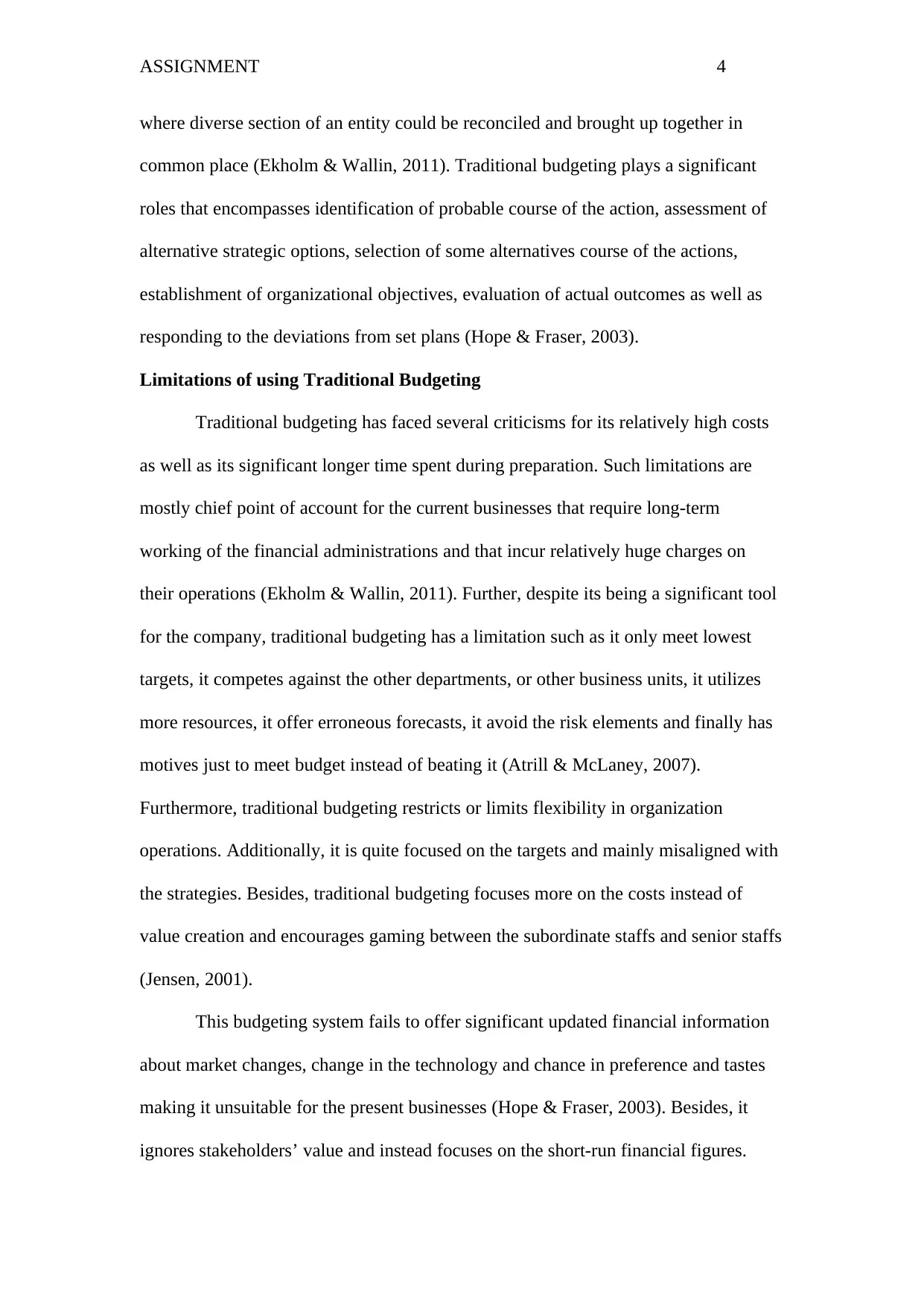
ASSIGNMENT 4
where diverse section of an entity could be reconciled and brought up together in
common place (Ekholm & Wallin, 2011). Traditional budgeting plays a significant
roles that encompasses identification of probable course of the action, assessment of
alternative strategic options, selection of some alternatives course of the actions,
establishment of organizational objectives, evaluation of actual outcomes as well as
responding to the deviations from set plans (Hope & Fraser, 2003).
Limitations of using Traditional Budgeting
Traditional budgeting has faced several criticisms for its relatively high costs
as well as its significant longer time spent during preparation. Such limitations are
mostly chief point of account for the current businesses that require long-term
working of the financial administrations and that incur relatively huge charges on
their operations (Ekholm & Wallin, 2011). Further, despite its being a significant tool
for the company, traditional budgeting has a limitation such as it only meet lowest
targets, it competes against the other departments, or other business units, it utilizes
more resources, it offer erroneous forecasts, it avoid the risk elements and finally has
motives just to meet budget instead of beating it (Atrill & McLaney, 2007).
Furthermore, traditional budgeting restricts or limits flexibility in organization
operations. Additionally, it is quite focused on the targets and mainly misaligned with
the strategies. Besides, traditional budgeting focuses more on the costs instead of
value creation and encourages gaming between the subordinate staffs and senior staffs
(Jensen, 2001).
This budgeting system fails to offer significant updated financial information
about market changes, change in the technology and chance in preference and tastes
making it unsuitable for the present businesses (Hope & Fraser, 2003). Besides, it
ignores stakeholders’ value and instead focuses on the short-run financial figures.
where diverse section of an entity could be reconciled and brought up together in
common place (Ekholm & Wallin, 2011). Traditional budgeting plays a significant
roles that encompasses identification of probable course of the action, assessment of
alternative strategic options, selection of some alternatives course of the actions,
establishment of organizational objectives, evaluation of actual outcomes as well as
responding to the deviations from set plans (Hope & Fraser, 2003).
Limitations of using Traditional Budgeting
Traditional budgeting has faced several criticisms for its relatively high costs
as well as its significant longer time spent during preparation. Such limitations are
mostly chief point of account for the current businesses that require long-term
working of the financial administrations and that incur relatively huge charges on
their operations (Ekholm & Wallin, 2011). Further, despite its being a significant tool
for the company, traditional budgeting has a limitation such as it only meet lowest
targets, it competes against the other departments, or other business units, it utilizes
more resources, it offer erroneous forecasts, it avoid the risk elements and finally has
motives just to meet budget instead of beating it (Atrill & McLaney, 2007).
Furthermore, traditional budgeting restricts or limits flexibility in organization
operations. Additionally, it is quite focused on the targets and mainly misaligned with
the strategies. Besides, traditional budgeting focuses more on the costs instead of
value creation and encourages gaming between the subordinate staffs and senior staffs
(Jensen, 2001).
This budgeting system fails to offer significant updated financial information
about market changes, change in the technology and chance in preference and tastes
making it unsuitable for the present businesses (Hope & Fraser, 2003). Besides, it
ignores stakeholders’ value and instead focuses on the short-run financial figures.
Paraphrase This Document
Need a fresh take? Get an instant paraphrase of this document with our AI Paraphraser
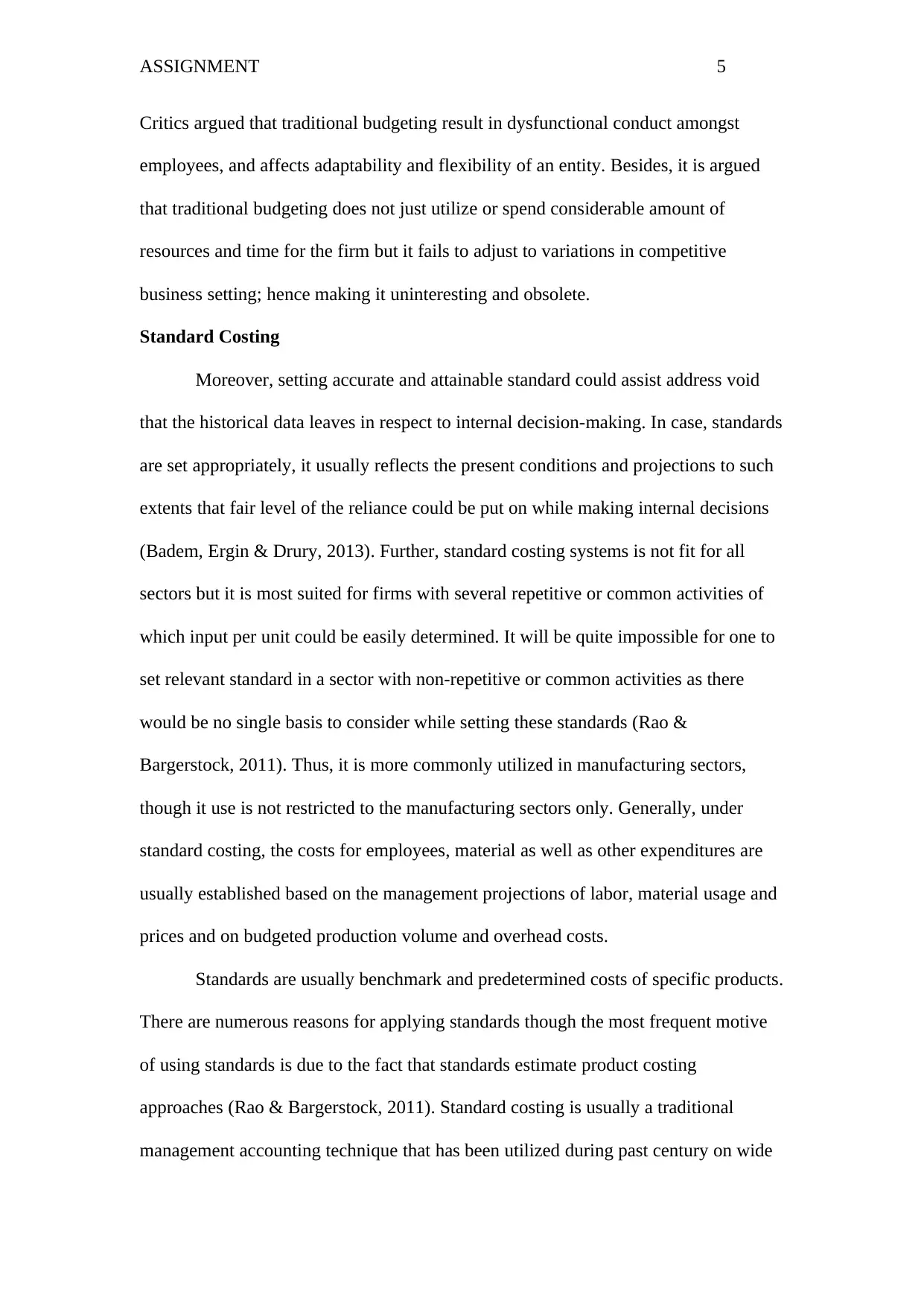
ASSIGNMENT 5
Critics argued that traditional budgeting result in dysfunctional conduct amongst
employees, and affects adaptability and flexibility of an entity. Besides, it is argued
that traditional budgeting does not just utilize or spend considerable amount of
resources and time for the firm but it fails to adjust to variations in competitive
business setting; hence making it uninteresting and obsolete.
Standard Costing
Moreover, setting accurate and attainable standard could assist address void
that the historical data leaves in respect to internal decision-making. In case, standards
are set appropriately, it usually reflects the present conditions and projections to such
extents that fair level of the reliance could be put on while making internal decisions
(Badem, Ergin & Drury, 2013). Further, standard costing systems is not fit for all
sectors but it is most suited for firms with several repetitive or common activities of
which input per unit could be easily determined. It will be quite impossible for one to
set relevant standard in a sector with non-repetitive or common activities as there
would be no single basis to consider while setting these standards (Rao &
Bargerstock, 2011). Thus, it is more commonly utilized in manufacturing sectors,
though it use is not restricted to the manufacturing sectors only. Generally, under
standard costing, the costs for employees, material as well as other expenditures are
usually established based on the management projections of labor, material usage and
prices and on budgeted production volume and overhead costs.
Standards are usually benchmark and predetermined costs of specific products.
There are numerous reasons for applying standards though the most frequent motive
of using standards is due to the fact that standards estimate product costing
approaches (Rao & Bargerstock, 2011). Standard costing is usually a traditional
management accounting technique that has been utilized during past century on wide
Critics argued that traditional budgeting result in dysfunctional conduct amongst
employees, and affects adaptability and flexibility of an entity. Besides, it is argued
that traditional budgeting does not just utilize or spend considerable amount of
resources and time for the firm but it fails to adjust to variations in competitive
business setting; hence making it uninteresting and obsolete.
Standard Costing
Moreover, setting accurate and attainable standard could assist address void
that the historical data leaves in respect to internal decision-making. In case, standards
are set appropriately, it usually reflects the present conditions and projections to such
extents that fair level of the reliance could be put on while making internal decisions
(Badem, Ergin & Drury, 2013). Further, standard costing systems is not fit for all
sectors but it is most suited for firms with several repetitive or common activities of
which input per unit could be easily determined. It will be quite impossible for one to
set relevant standard in a sector with non-repetitive or common activities as there
would be no single basis to consider while setting these standards (Rao &
Bargerstock, 2011). Thus, it is more commonly utilized in manufacturing sectors,
though it use is not restricted to the manufacturing sectors only. Generally, under
standard costing, the costs for employees, material as well as other expenditures are
usually established based on the management projections of labor, material usage and
prices and on budgeted production volume and overhead costs.
Standards are usually benchmark and predetermined costs of specific products.
There are numerous reasons for applying standards though the most frequent motive
of using standards is due to the fact that standards estimate product costing
approaches (Rao & Bargerstock, 2011). Standard costing is usually a traditional
management accounting technique that has been utilized during past century on wide
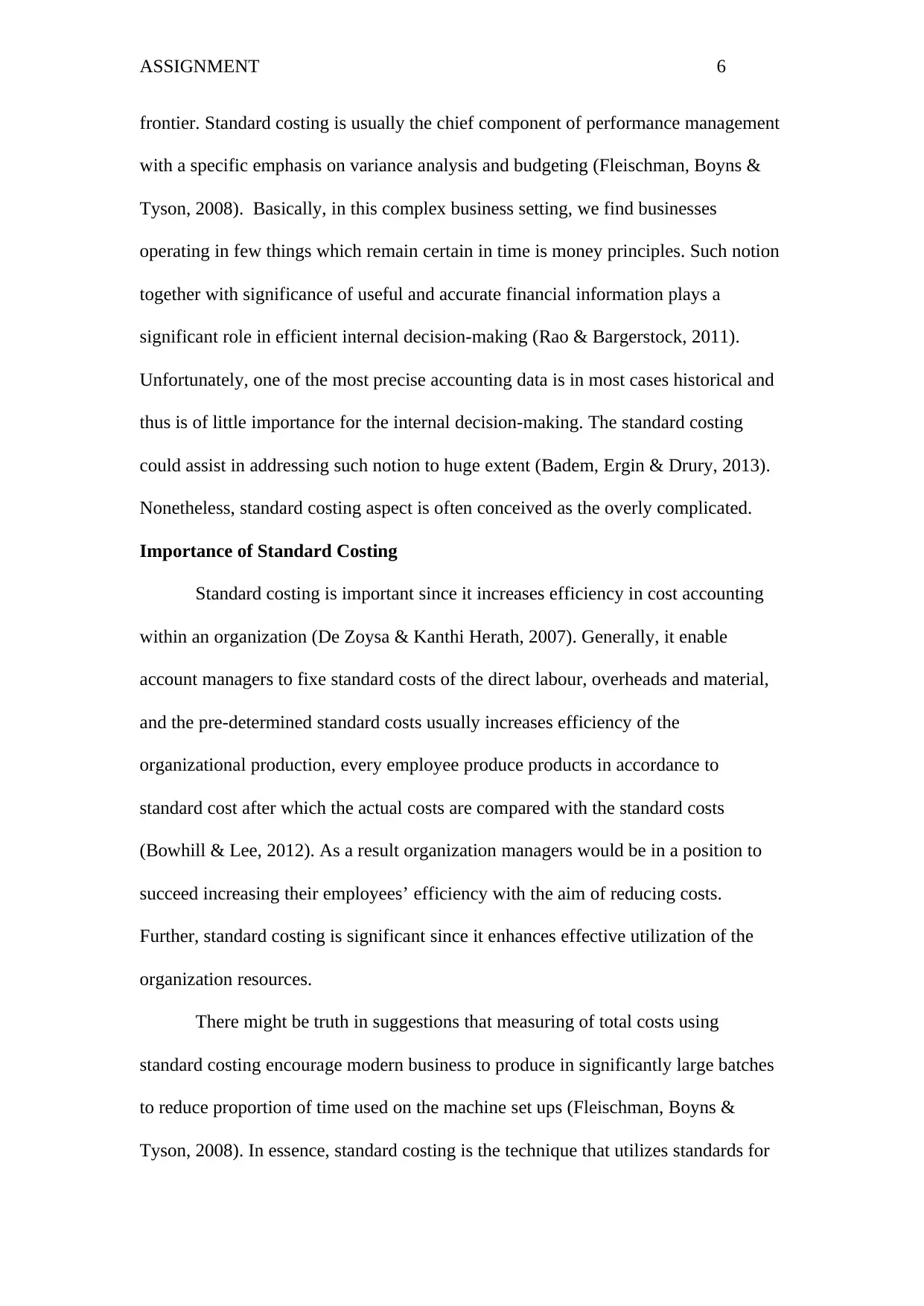
ASSIGNMENT 6
frontier. Standard costing is usually the chief component of performance management
with a specific emphasis on variance analysis and budgeting (Fleischman, Boyns &
Tyson, 2008). Basically, in this complex business setting, we find businesses
operating in few things which remain certain in time is money principles. Such notion
together with significance of useful and accurate financial information plays a
significant role in efficient internal decision-making (Rao & Bargerstock, 2011).
Unfortunately, one of the most precise accounting data is in most cases historical and
thus is of little importance for the internal decision-making. The standard costing
could assist in addressing such notion to huge extent (Badem, Ergin & Drury, 2013).
Nonetheless, standard costing aspect is often conceived as the overly complicated.
Importance of Standard Costing
Standard costing is important since it increases efficiency in cost accounting
within an organization (De Zoysa & Kanthi Herath, 2007). Generally, it enable
account managers to fixe standard costs of the direct labour, overheads and material,
and the pre-determined standard costs usually increases efficiency of the
organizational production, every employee produce products in accordance to
standard cost after which the actual costs are compared with the standard costs
(Bowhill & Lee, 2012). As a result organization managers would be in a position to
succeed increasing their employees’ efficiency with the aim of reducing costs.
Further, standard costing is significant since it enhances effective utilization of the
organization resources.
There might be truth in suggestions that measuring of total costs using
standard costing encourage modern business to produce in significantly large batches
to reduce proportion of time used on the machine set ups (Fleischman, Boyns &
Tyson, 2008). In essence, standard costing is the technique that utilizes standards for
frontier. Standard costing is usually the chief component of performance management
with a specific emphasis on variance analysis and budgeting (Fleischman, Boyns &
Tyson, 2008). Basically, in this complex business setting, we find businesses
operating in few things which remain certain in time is money principles. Such notion
together with significance of useful and accurate financial information plays a
significant role in efficient internal decision-making (Rao & Bargerstock, 2011).
Unfortunately, one of the most precise accounting data is in most cases historical and
thus is of little importance for the internal decision-making. The standard costing
could assist in addressing such notion to huge extent (Badem, Ergin & Drury, 2013).
Nonetheless, standard costing aspect is often conceived as the overly complicated.
Importance of Standard Costing
Standard costing is important since it increases efficiency in cost accounting
within an organization (De Zoysa & Kanthi Herath, 2007). Generally, it enable
account managers to fixe standard costs of the direct labour, overheads and material,
and the pre-determined standard costs usually increases efficiency of the
organizational production, every employee produce products in accordance to
standard cost after which the actual costs are compared with the standard costs
(Bowhill & Lee, 2012). As a result organization managers would be in a position to
succeed increasing their employees’ efficiency with the aim of reducing costs.
Further, standard costing is significant since it enhances effective utilization of the
organization resources.
There might be truth in suggestions that measuring of total costs using
standard costing encourage modern business to produce in significantly large batches
to reduce proportion of time used on the machine set ups (Fleischman, Boyns &
Tyson, 2008). In essence, standard costing is the technique that utilizes standards for
⊘ This is a preview!⊘
Do you want full access?
Subscribe today to unlock all pages.

Trusted by 1+ million students worldwide
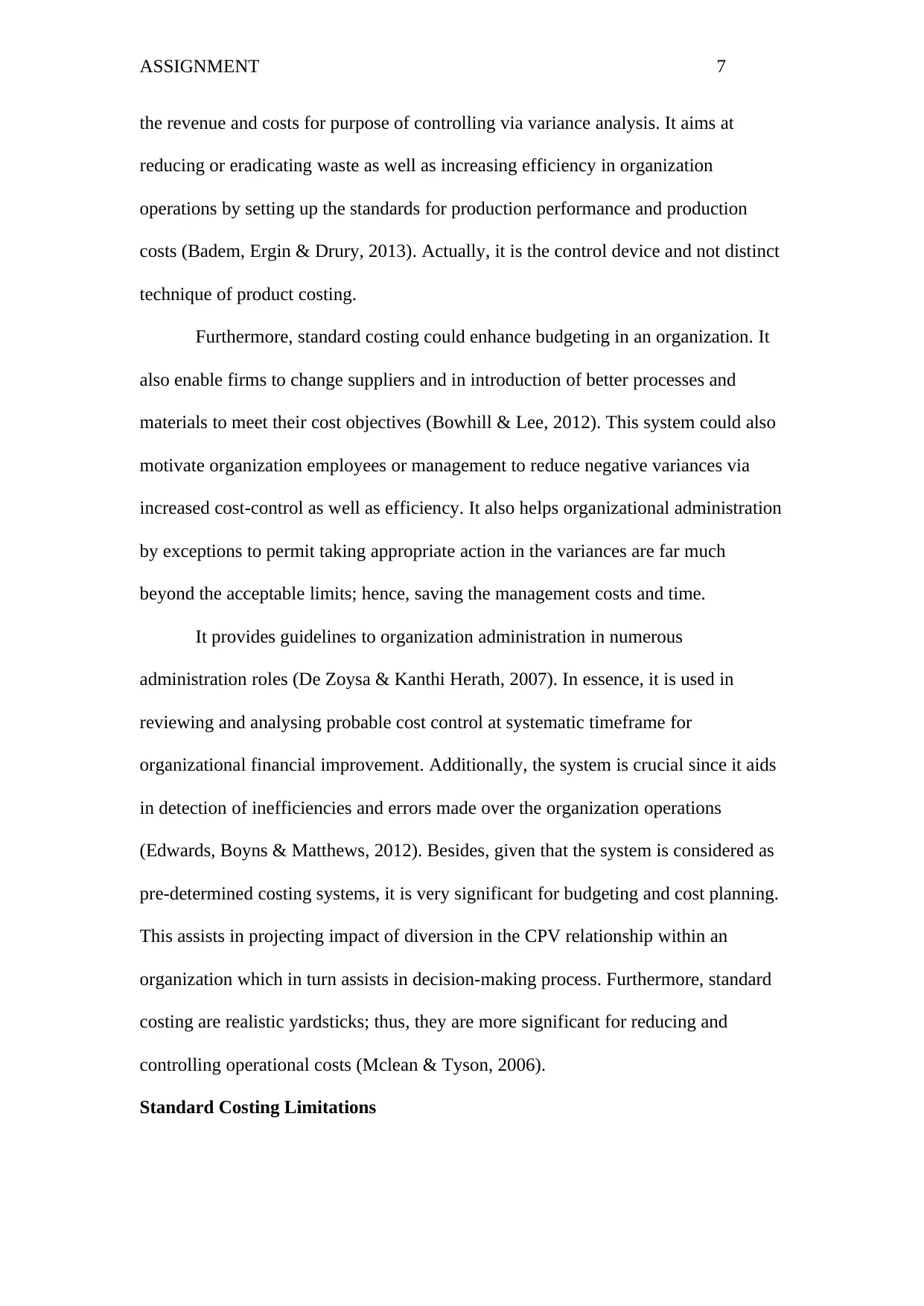
ASSIGNMENT 7
the revenue and costs for purpose of controlling via variance analysis. It aims at
reducing or eradicating waste as well as increasing efficiency in organization
operations by setting up the standards for production performance and production
costs (Badem, Ergin & Drury, 2013). Actually, it is the control device and not distinct
technique of product costing.
Furthermore, standard costing could enhance budgeting in an organization. It
also enable firms to change suppliers and in introduction of better processes and
materials to meet their cost objectives (Bowhill & Lee, 2012). This system could also
motivate organization employees or management to reduce negative variances via
increased cost-control as well as efficiency. It also helps organizational administration
by exceptions to permit taking appropriate action in the variances are far much
beyond the acceptable limits; hence, saving the management costs and time.
It provides guidelines to organization administration in numerous
administration roles (De Zoysa & Kanthi Herath, 2007). In essence, it is used in
reviewing and analysing probable cost control at systematic timeframe for
organizational financial improvement. Additionally, the system is crucial since it aids
in detection of inefficiencies and errors made over the organization operations
(Edwards, Boyns & Matthews, 2012). Besides, given that the system is considered as
pre-determined costing systems, it is very significant for budgeting and cost planning.
This assists in projecting impact of diversion in the CPV relationship within an
organization which in turn assists in decision-making process. Furthermore, standard
costing are realistic yardsticks; thus, they are more significant for reducing and
controlling operational costs (Mclean & Tyson, 2006).
Standard Costing Limitations
the revenue and costs for purpose of controlling via variance analysis. It aims at
reducing or eradicating waste as well as increasing efficiency in organization
operations by setting up the standards for production performance and production
costs (Badem, Ergin & Drury, 2013). Actually, it is the control device and not distinct
technique of product costing.
Furthermore, standard costing could enhance budgeting in an organization. It
also enable firms to change suppliers and in introduction of better processes and
materials to meet their cost objectives (Bowhill & Lee, 2012). This system could also
motivate organization employees or management to reduce negative variances via
increased cost-control as well as efficiency. It also helps organizational administration
by exceptions to permit taking appropriate action in the variances are far much
beyond the acceptable limits; hence, saving the management costs and time.
It provides guidelines to organization administration in numerous
administration roles (De Zoysa & Kanthi Herath, 2007). In essence, it is used in
reviewing and analysing probable cost control at systematic timeframe for
organizational financial improvement. Additionally, the system is crucial since it aids
in detection of inefficiencies and errors made over the organization operations
(Edwards, Boyns & Matthews, 2012). Besides, given that the system is considered as
pre-determined costing systems, it is very significant for budgeting and cost planning.
This assists in projecting impact of diversion in the CPV relationship within an
organization which in turn assists in decision-making process. Furthermore, standard
costing are realistic yardsticks; thus, they are more significant for reducing and
controlling operational costs (Mclean & Tyson, 2006).
Standard Costing Limitations
Paraphrase This Document
Need a fresh take? Get an instant paraphrase of this document with our AI Paraphraser
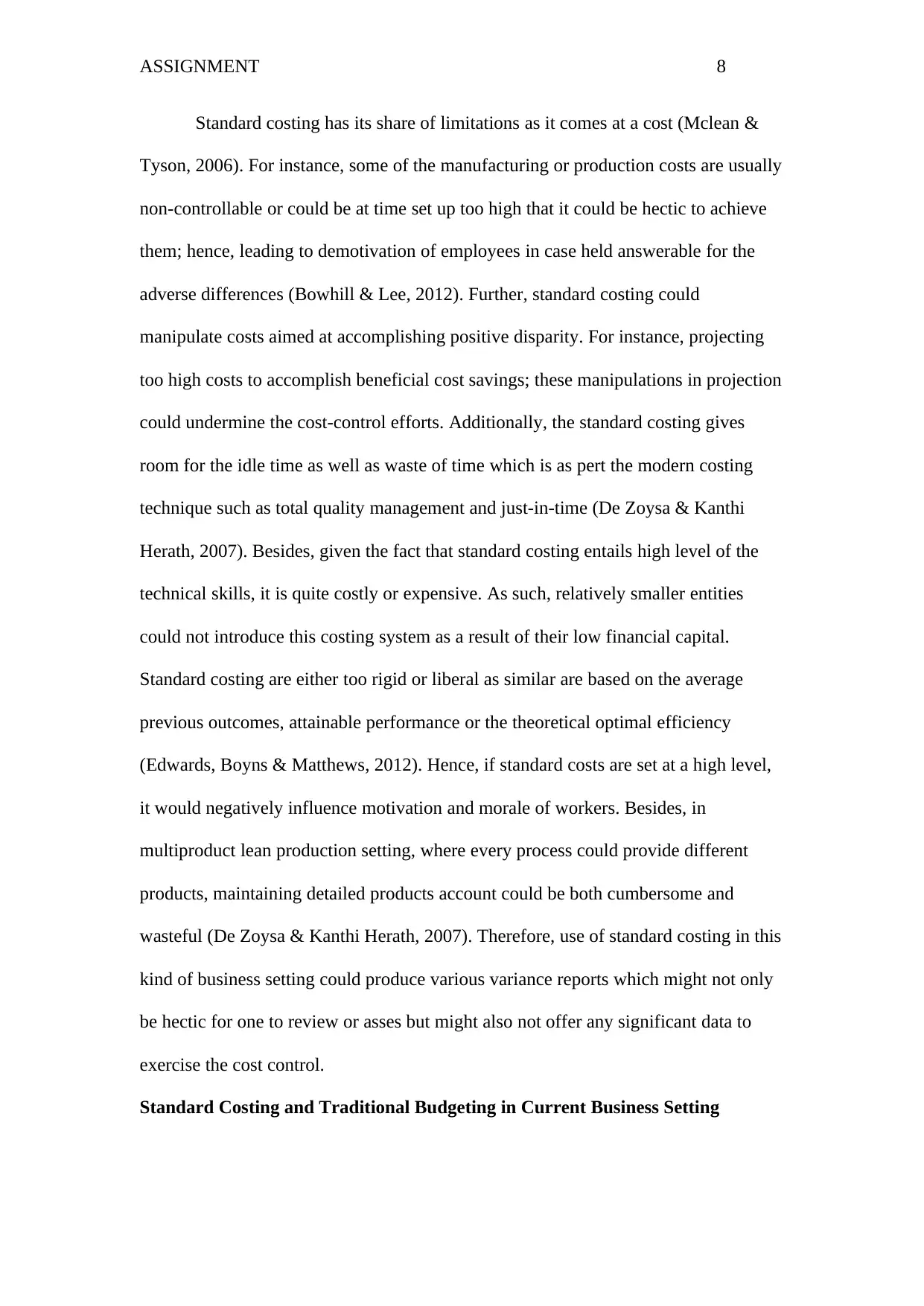
ASSIGNMENT 8
Standard costing has its share of limitations as it comes at a cost (Mclean &
Tyson, 2006). For instance, some of the manufacturing or production costs are usually
non-controllable or could be at time set up too high that it could be hectic to achieve
them; hence, leading to demotivation of employees in case held answerable for the
adverse differences (Bowhill & Lee, 2012). Further, standard costing could
manipulate costs aimed at accomplishing positive disparity. For instance, projecting
too high costs to accomplish beneficial cost savings; these manipulations in projection
could undermine the cost-control efforts. Additionally, the standard costing gives
room for the idle time as well as waste of time which is as pert the modern costing
technique such as total quality management and just-in-time (De Zoysa & Kanthi
Herath, 2007). Besides, given the fact that standard costing entails high level of the
technical skills, it is quite costly or expensive. As such, relatively smaller entities
could not introduce this costing system as a result of their low financial capital.
Standard costing are either too rigid or liberal as similar are based on the average
previous outcomes, attainable performance or the theoretical optimal efficiency
(Edwards, Boyns & Matthews, 2012). Hence, if standard costs are set at a high level,
it would negatively influence motivation and morale of workers. Besides, in
multiproduct lean production setting, where every process could provide different
products, maintaining detailed products account could be both cumbersome and
wasteful (De Zoysa & Kanthi Herath, 2007). Therefore, use of standard costing in this
kind of business setting could produce various variance reports which might not only
be hectic for one to review or asses but might also not offer any significant data to
exercise the cost control.
Standard Costing and Traditional Budgeting in Current Business Setting
Standard costing has its share of limitations as it comes at a cost (Mclean &
Tyson, 2006). For instance, some of the manufacturing or production costs are usually
non-controllable or could be at time set up too high that it could be hectic to achieve
them; hence, leading to demotivation of employees in case held answerable for the
adverse differences (Bowhill & Lee, 2012). Further, standard costing could
manipulate costs aimed at accomplishing positive disparity. For instance, projecting
too high costs to accomplish beneficial cost savings; these manipulations in projection
could undermine the cost-control efforts. Additionally, the standard costing gives
room for the idle time as well as waste of time which is as pert the modern costing
technique such as total quality management and just-in-time (De Zoysa & Kanthi
Herath, 2007). Besides, given the fact that standard costing entails high level of the
technical skills, it is quite costly or expensive. As such, relatively smaller entities
could not introduce this costing system as a result of their low financial capital.
Standard costing are either too rigid or liberal as similar are based on the average
previous outcomes, attainable performance or the theoretical optimal efficiency
(Edwards, Boyns & Matthews, 2012). Hence, if standard costs are set at a high level,
it would negatively influence motivation and morale of workers. Besides, in
multiproduct lean production setting, where every process could provide different
products, maintaining detailed products account could be both cumbersome and
wasteful (De Zoysa & Kanthi Herath, 2007). Therefore, use of standard costing in this
kind of business setting could produce various variance reports which might not only
be hectic for one to review or asses but might also not offer any significant data to
exercise the cost control.
Standard Costing and Traditional Budgeting in Current Business Setting
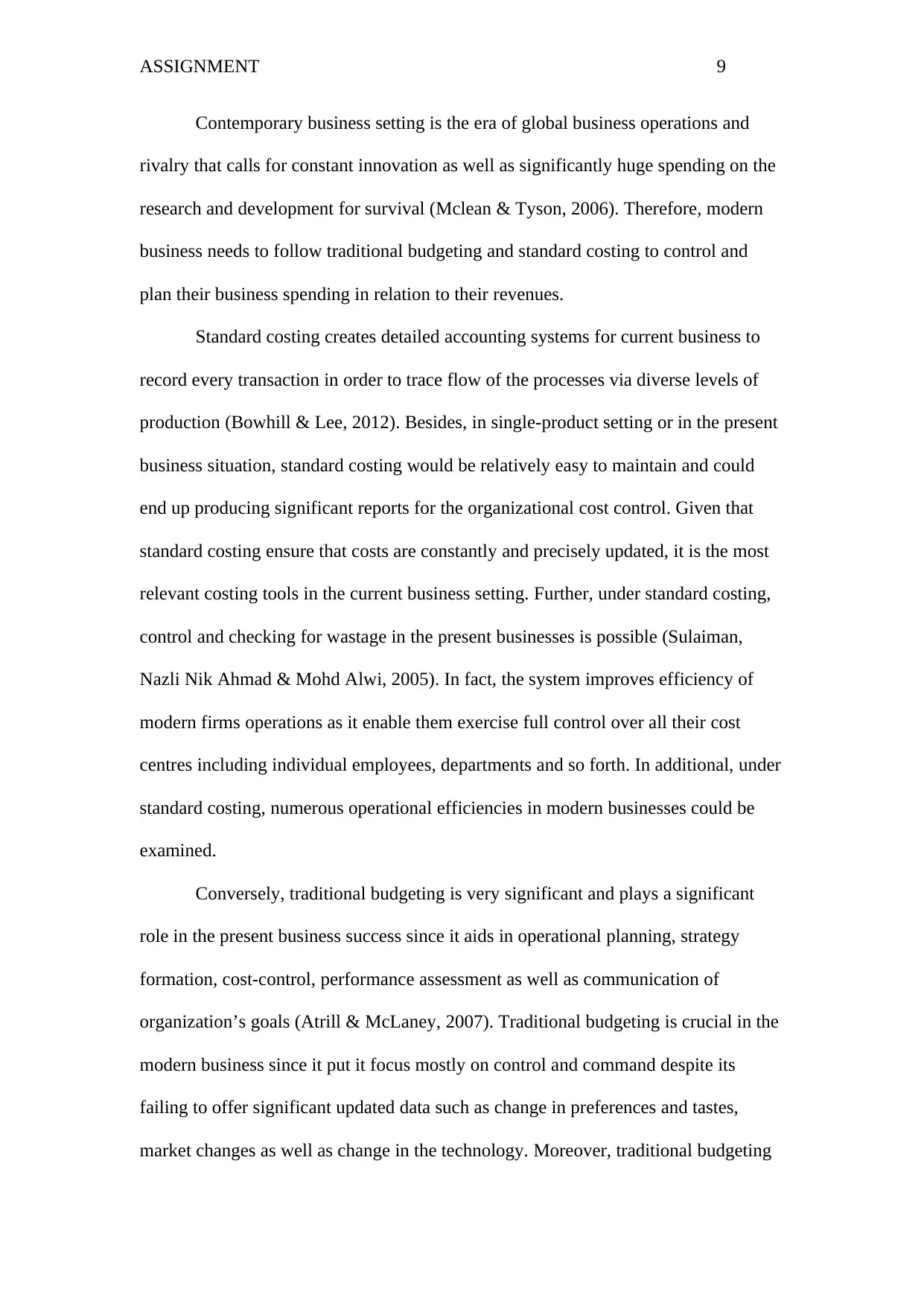
ASSIGNMENT 9
Contemporary business setting is the era of global business operations and
rivalry that calls for constant innovation as well as significantly huge spending on the
research and development for survival (Mclean & Tyson, 2006). Therefore, modern
business needs to follow traditional budgeting and standard costing to control and
plan their business spending in relation to their revenues.
Standard costing creates detailed accounting systems for current business to
record every transaction in order to trace flow of the processes via diverse levels of
production (Bowhill & Lee, 2012). Besides, in single-product setting or in the present
business situation, standard costing would be relatively easy to maintain and could
end up producing significant reports for the organizational cost control. Given that
standard costing ensure that costs are constantly and precisely updated, it is the most
relevant costing tools in the current business setting. Further, under standard costing,
control and checking for wastage in the present businesses is possible (Sulaiman,
Nazli Nik Ahmad & Mohd Alwi, 2005). In fact, the system improves efficiency of
modern firms operations as it enable them exercise full control over all their cost
centres including individual employees, departments and so forth. In additional, under
standard costing, numerous operational efficiencies in modern businesses could be
examined.
Conversely, traditional budgeting is very significant and plays a significant
role in the present business success since it aids in operational planning, strategy
formation, cost-control, performance assessment as well as communication of
organization’s goals (Atrill & McLaney, 2007). Traditional budgeting is crucial in the
modern business since it put it focus mostly on control and command despite its
failing to offer significant updated data such as change in preferences and tastes,
market changes as well as change in the technology. Moreover, traditional budgeting
Contemporary business setting is the era of global business operations and
rivalry that calls for constant innovation as well as significantly huge spending on the
research and development for survival (Mclean & Tyson, 2006). Therefore, modern
business needs to follow traditional budgeting and standard costing to control and
plan their business spending in relation to their revenues.
Standard costing creates detailed accounting systems for current business to
record every transaction in order to trace flow of the processes via diverse levels of
production (Bowhill & Lee, 2012). Besides, in single-product setting or in the present
business situation, standard costing would be relatively easy to maintain and could
end up producing significant reports for the organizational cost control. Given that
standard costing ensure that costs are constantly and precisely updated, it is the most
relevant costing tools in the current business setting. Further, under standard costing,
control and checking for wastage in the present businesses is possible (Sulaiman,
Nazli Nik Ahmad & Mohd Alwi, 2005). In fact, the system improves efficiency of
modern firms operations as it enable them exercise full control over all their cost
centres including individual employees, departments and so forth. In additional, under
standard costing, numerous operational efficiencies in modern businesses could be
examined.
Conversely, traditional budgeting is very significant and plays a significant
role in the present business success since it aids in operational planning, strategy
formation, cost-control, performance assessment as well as communication of
organization’s goals (Atrill & McLaney, 2007). Traditional budgeting is crucial in the
modern business since it put it focus mostly on control and command despite its
failing to offer significant updated data such as change in preferences and tastes,
market changes as well as change in the technology. Moreover, traditional budgeting
⊘ This is a preview!⊘
Do you want full access?
Subscribe today to unlock all pages.

Trusted by 1+ million students worldwide
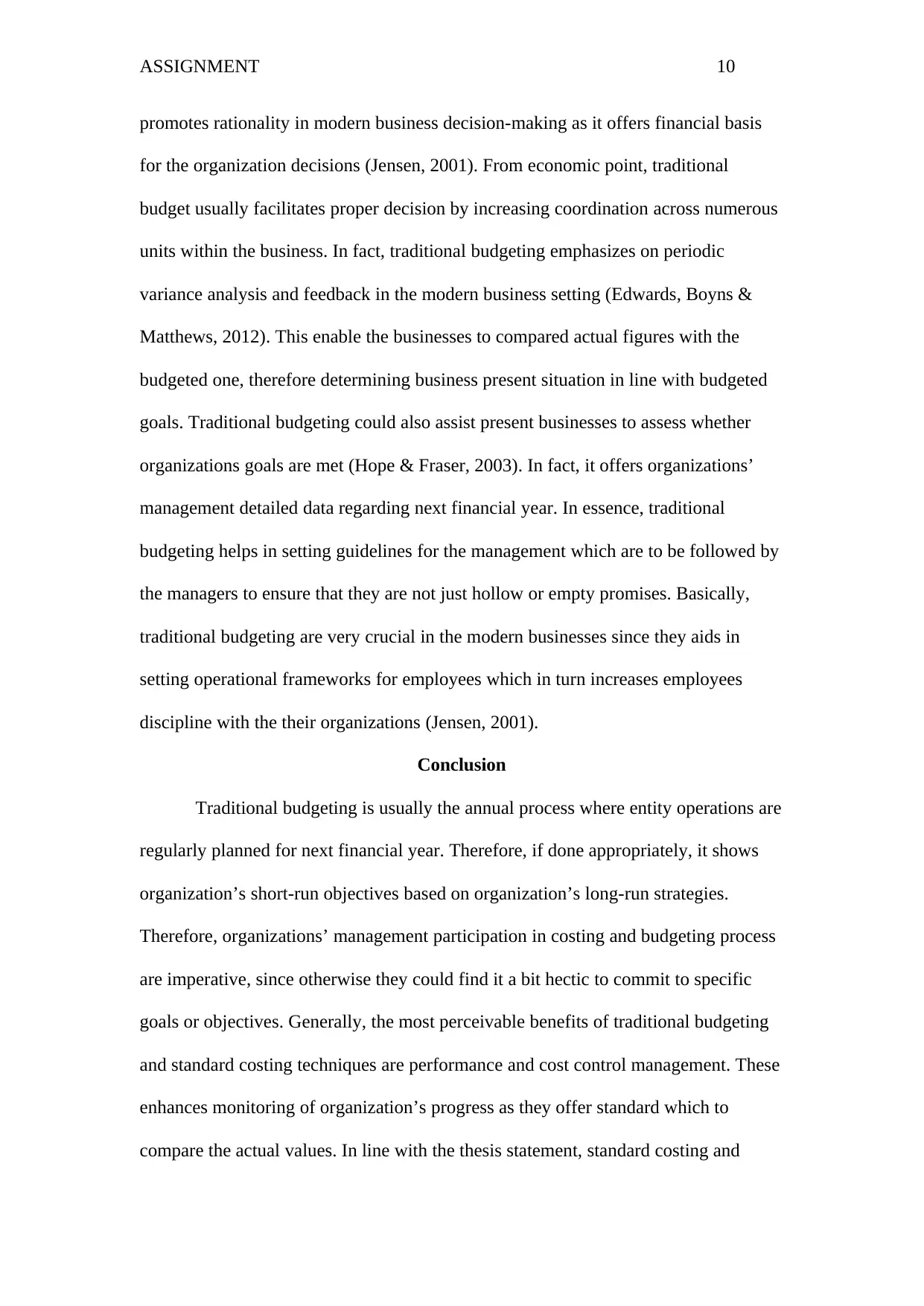
ASSIGNMENT 10
promotes rationality in modern business decision-making as it offers financial basis
for the organization decisions (Jensen, 2001). From economic point, traditional
budget usually facilitates proper decision by increasing coordination across numerous
units within the business. In fact, traditional budgeting emphasizes on periodic
variance analysis and feedback in the modern business setting (Edwards, Boyns &
Matthews, 2012). This enable the businesses to compared actual figures with the
budgeted one, therefore determining business present situation in line with budgeted
goals. Traditional budgeting could also assist present businesses to assess whether
organizations goals are met (Hope & Fraser, 2003). In fact, it offers organizations’
management detailed data regarding next financial year. In essence, traditional
budgeting helps in setting guidelines for the management which are to be followed by
the managers to ensure that they are not just hollow or empty promises. Basically,
traditional budgeting are very crucial in the modern businesses since they aids in
setting operational frameworks for employees which in turn increases employees
discipline with the their organizations (Jensen, 2001).
Conclusion
Traditional budgeting is usually the annual process where entity operations are
regularly planned for next financial year. Therefore, if done appropriately, it shows
organization’s short-run objectives based on organization’s long-run strategies.
Therefore, organizations’ management participation in costing and budgeting process
are imperative, since otherwise they could find it a bit hectic to commit to specific
goals or objectives. Generally, the most perceivable benefits of traditional budgeting
and standard costing techniques are performance and cost control management. These
enhances monitoring of organization’s progress as they offer standard which to
compare the actual values. In line with the thesis statement, standard costing and
promotes rationality in modern business decision-making as it offers financial basis
for the organization decisions (Jensen, 2001). From economic point, traditional
budget usually facilitates proper decision by increasing coordination across numerous
units within the business. In fact, traditional budgeting emphasizes on periodic
variance analysis and feedback in the modern business setting (Edwards, Boyns &
Matthews, 2012). This enable the businesses to compared actual figures with the
budgeted one, therefore determining business present situation in line with budgeted
goals. Traditional budgeting could also assist present businesses to assess whether
organizations goals are met (Hope & Fraser, 2003). In fact, it offers organizations’
management detailed data regarding next financial year. In essence, traditional
budgeting helps in setting guidelines for the management which are to be followed by
the managers to ensure that they are not just hollow or empty promises. Basically,
traditional budgeting are very crucial in the modern businesses since they aids in
setting operational frameworks for employees which in turn increases employees
discipline with the their organizations (Jensen, 2001).
Conclusion
Traditional budgeting is usually the annual process where entity operations are
regularly planned for next financial year. Therefore, if done appropriately, it shows
organization’s short-run objectives based on organization’s long-run strategies.
Therefore, organizations’ management participation in costing and budgeting process
are imperative, since otherwise they could find it a bit hectic to commit to specific
goals or objectives. Generally, the most perceivable benefits of traditional budgeting
and standard costing techniques are performance and cost control management. These
enhances monitoring of organization’s progress as they offer standard which to
compare the actual values. In line with the thesis statement, standard costing and
Paraphrase This Document
Need a fresh take? Get an instant paraphrase of this document with our AI Paraphraser
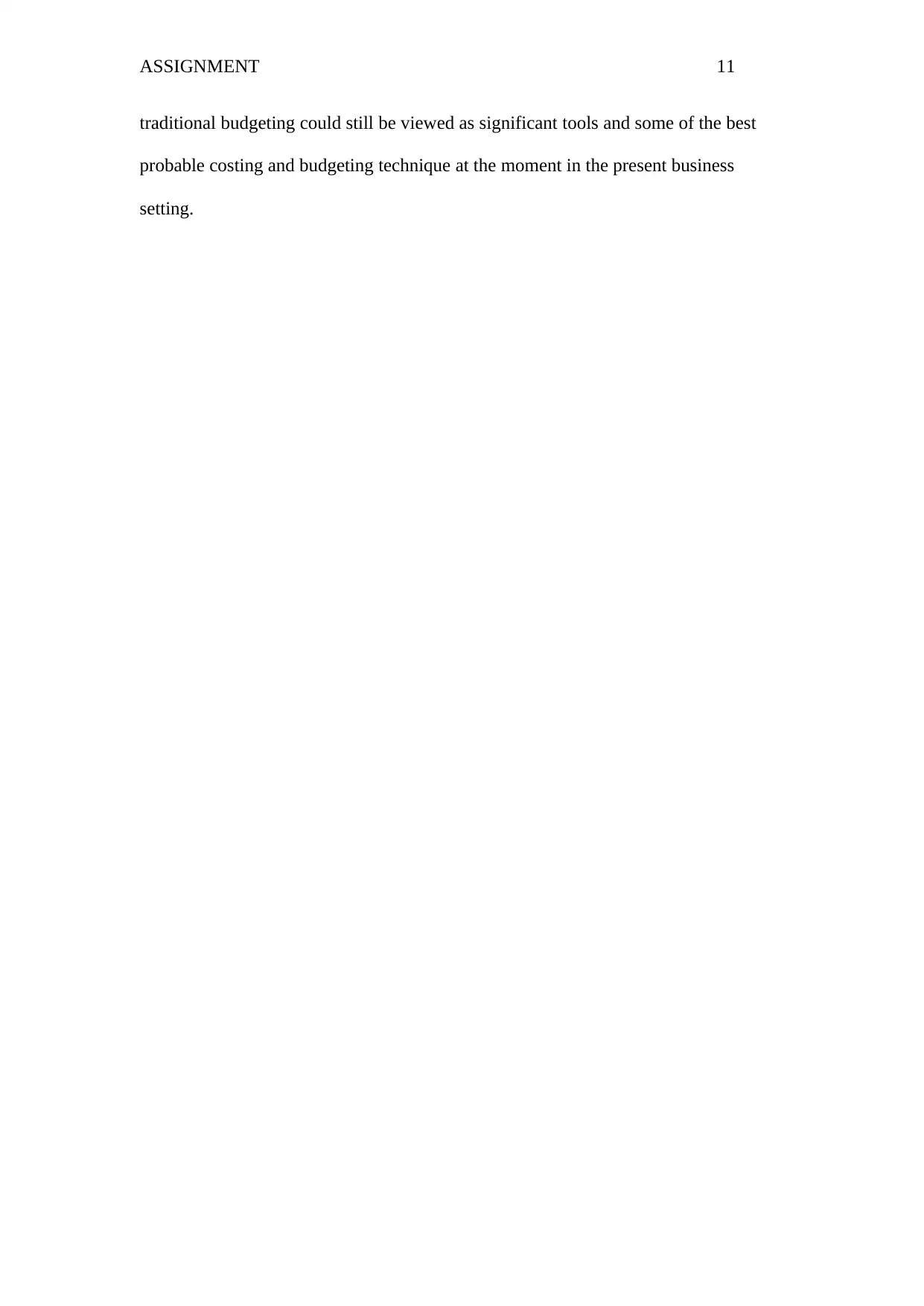
ASSIGNMENT 11
traditional budgeting could still be viewed as significant tools and some of the best
probable costing and budgeting technique at the moment in the present business
setting.
traditional budgeting could still be viewed as significant tools and some of the best
probable costing and budgeting technique at the moment in the present business
setting.
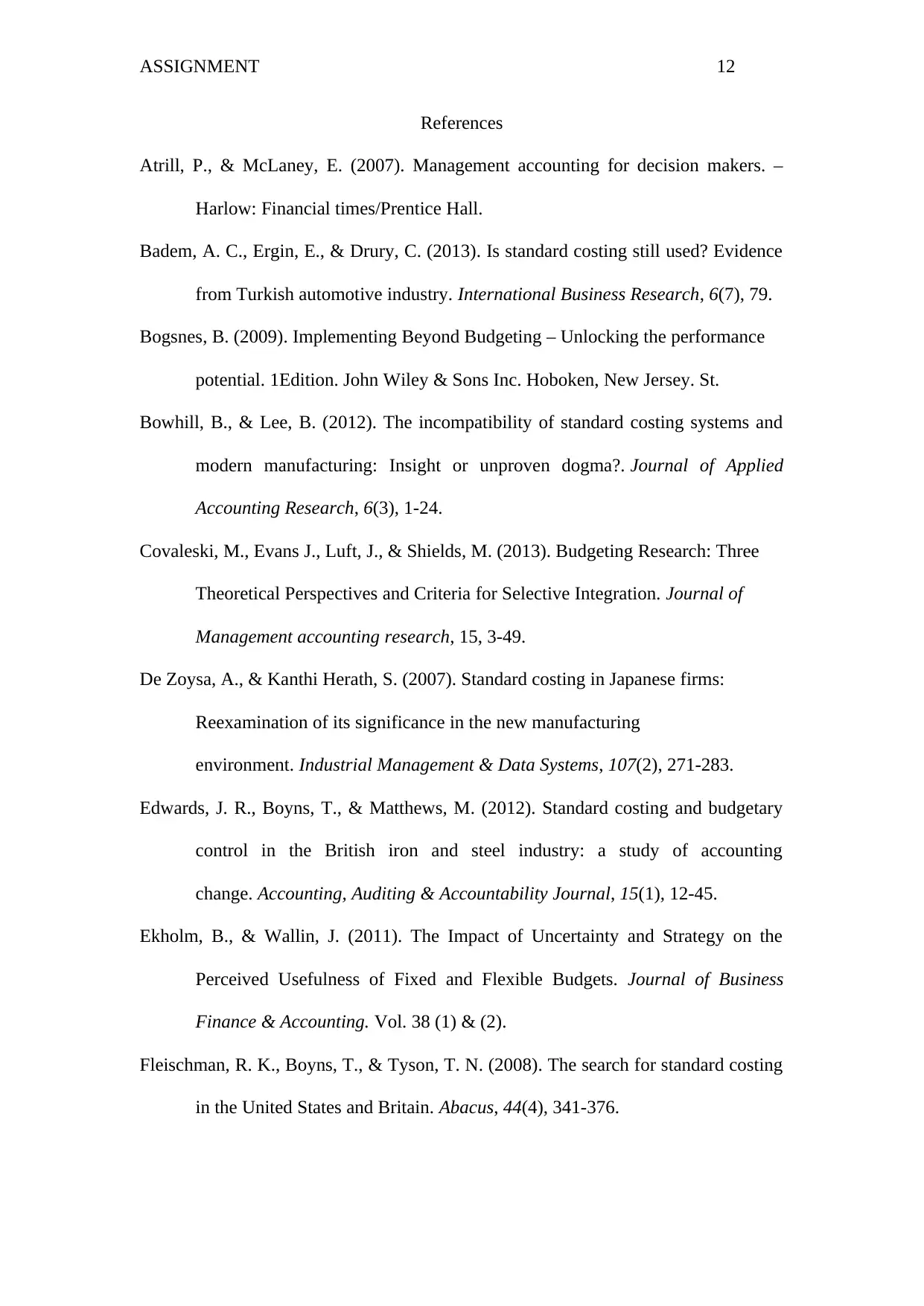
ASSIGNMENT 12
References
Atrill, P., & McLaney, E. (2007). Management accounting for decision makers. –
Harlow: Financial times/Prentice Hall.
Badem, A. C., Ergin, E., & Drury, C. (2013). Is standard costing still used? Evidence
from Turkish automotive industry. International Business Research, 6(7), 79.
Bogsnes, B. (2009). Implementing Beyond Budgeting – Unlocking the performance
potential. 1Edition. John Wiley & Sons Inc. Hoboken, New Jersey. St.
Bowhill, B., & Lee, B. (2012). The incompatibility of standard costing systems and
modern manufacturing: Insight or unproven dogma?. Journal of Applied
Accounting Research, 6(3), 1-24.
Covaleski, M., Evans J., Luft, J., & Shields, M. (2013). Budgeting Research: Three
Theoretical Perspectives and Criteria for Selective Integration. Journal of
Management accounting research, 15, 3-49.
De Zoysa, A., & Kanthi Herath, S. (2007). Standard costing in Japanese firms:
Reexamination of its significance in the new manufacturing
environment. Industrial Management & Data Systems, 107(2), 271-283.
Edwards, J. R., Boyns, T., & Matthews, M. (2012). Standard costing and budgetary
control in the British iron and steel industry: a study of accounting
change. Accounting, Auditing & Accountability Journal, 15(1), 12-45.
Ekholm, B., & Wallin, J. (2011). The Impact of Uncertainty and Strategy on the
Perceived Usefulness of Fixed and Flexible Budgets. Journal of Business
Finance & Accounting. Vol. 38 (1) & (2).
Fleischman, R. K., Boyns, T., & Tyson, T. N. (2008). The search for standard costing
in the United States and Britain. Abacus, 44(4), 341-376.
References
Atrill, P., & McLaney, E. (2007). Management accounting for decision makers. –
Harlow: Financial times/Prentice Hall.
Badem, A. C., Ergin, E., & Drury, C. (2013). Is standard costing still used? Evidence
from Turkish automotive industry. International Business Research, 6(7), 79.
Bogsnes, B. (2009). Implementing Beyond Budgeting – Unlocking the performance
potential. 1Edition. John Wiley & Sons Inc. Hoboken, New Jersey. St.
Bowhill, B., & Lee, B. (2012). The incompatibility of standard costing systems and
modern manufacturing: Insight or unproven dogma?. Journal of Applied
Accounting Research, 6(3), 1-24.
Covaleski, M., Evans J., Luft, J., & Shields, M. (2013). Budgeting Research: Three
Theoretical Perspectives and Criteria for Selective Integration. Journal of
Management accounting research, 15, 3-49.
De Zoysa, A., & Kanthi Herath, S. (2007). Standard costing in Japanese firms:
Reexamination of its significance in the new manufacturing
environment. Industrial Management & Data Systems, 107(2), 271-283.
Edwards, J. R., Boyns, T., & Matthews, M. (2012). Standard costing and budgetary
control in the British iron and steel industry: a study of accounting
change. Accounting, Auditing & Accountability Journal, 15(1), 12-45.
Ekholm, B., & Wallin, J. (2011). The Impact of Uncertainty and Strategy on the
Perceived Usefulness of Fixed and Flexible Budgets. Journal of Business
Finance & Accounting. Vol. 38 (1) & (2).
Fleischman, R. K., Boyns, T., & Tyson, T. N. (2008). The search for standard costing
in the United States and Britain. Abacus, 44(4), 341-376.
⊘ This is a preview!⊘
Do you want full access?
Subscribe today to unlock all pages.

Trusted by 1+ million students worldwide
1 out of 13
Related Documents
Your All-in-One AI-Powered Toolkit for Academic Success.
+13062052269
info@desklib.com
Available 24*7 on WhatsApp / Email
![[object Object]](/_next/static/media/star-bottom.7253800d.svg)
Unlock your academic potential
Copyright © 2020–2025 A2Z Services. All Rights Reserved. Developed and managed by ZUCOL.



